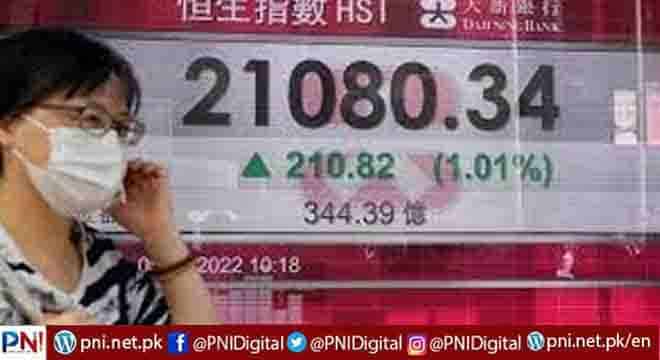Hong Kong, May 13 (AFP/APP): Asian equities were mostly up Friday following a tumultuous trading period on Wall Street, but analysts said the outlook remained bleak as inflation, the Ukraine war and Chinese lockdowns weigh on sentiment.
World markets have been volatile for much of 2022, with investors fretting about supply chain snarls due to China’s Covid curbs and as Europe weighs cutting out Russian oil over Moscow’s invasion.
The Federal Reserve last week announced its largest rate hike since 2000 to slow surging inflation and signaled that similar increases were likely in the coming months — a possibility that sent stocks on a rollercoaster.
But after Fed Chief Jerome Powell on Thursday said the United States was not actively considering a steeper 75-basis-point move, markets experienced a bounce in Asia.
“Asia-Pacific equities are staging a relief rally today after Wall Street stabilised late in the session as Jerome Powell calmed nerves over potential 0.75 percent rate hikes,” said Jeffrey Halley of OANDA.
However, he warned that the positive showing should be taken with a grain of salt.
“Nothing has materially changed in the world from yesterday, and if anything, Russia/Europe risks are increasing,” he said.
“The rally today looks more like a technical rebound after a torrid week than a structural turn in sentiment.”
After a bruising day on Wall Street — with the Dow falling for the sixth straight session — Asian equities opened higher Friday. Japan closed with a two percent bump.
Frankfurt, London and Paris all opened higher as well; while oil remained up, with the US benchmark crude WTI trading at more than $106 a barrel.
“Such intraday volatility and sentiment flip-flopping is indicative of nervous investors and in itself, a bearish signal,” said Lewis Grant of Federated Hermes Limited.
“As long as the war continues and macro pressures persist, it is likely that both energy names and value stocks will remain relative safe-havens for fully-invested, long-only equity investors.”
– Crypto seesaw –
Cryptocurrencies also saw great volatility this week. Bitcoin on Thursday tumbled below $27,000 — its lowest level since late 2020 — but by Friday its value was holding steady above $30,000.
Its temporary crash was fuelled by the collapse of two so-called “stablecoin” cryptocurrencies — TerraUSD and Tether — which proved to be anything but stable, leaving investors panicked.
While the digital currency market had stabilised by Friday, Stephen Innes of SPI Asset Management said “the seven-day moves in some of the ‘other crypto experiments’ on monster volume are insane and increasingly difficult to watch”.
– Key figures at around 0720 GMT –
Hong Kong – Hang Seng Index: UP 2.6 percent at 19,884.42
Shanghai – Composite: UP 0.9 percent at 3,084.28 (close)
London – FTSE 100: UP 0.7 percent at 7,287.09
Tokyo – Nikkei 225: UP 2.6 percent at 26,427.65 (close)
West Texas Intermediate: UP 0.7 percent at $106.88 per barrel
Brent North Sea crude: UP 1.0 percent at $108.53 per barrel
Euro/dollar: UP at $1.0394 from $1.0382 at 2100 GMT Thursday
Pound/dollar: UP at $1.2205 from $1.2199
Euro/pound: UP at 85.16 pence from 85.08 pence
Dollar/yen: DOWN at 128.53 yen from 129.97 yen
New York – Dow: DOWN 0.3 percent at 31,730.30 (close)
Follow the PNI Facebook page for the latest news and updates.








